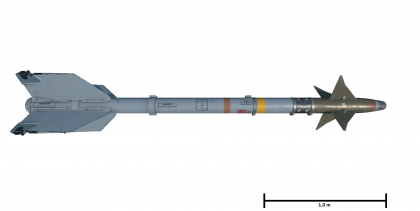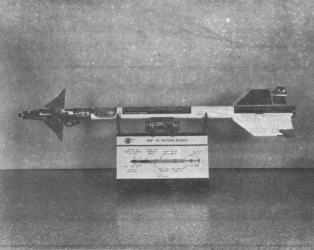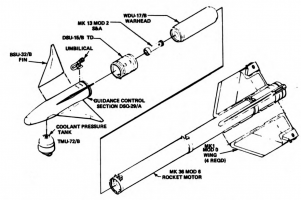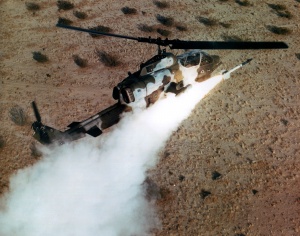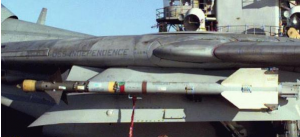Difference between revisions of "AIM-9L Sidewinder"
(User-made sidebars have been discontinued) |
Indo_Pilot (talk | contribs) (→Vehicles equipped with this weapon: Updated) |
||
| (76 intermediate revisions by 21 users not shown) | |||
| Line 1: | Line 1: | ||
| + | {{About | ||
| + | | about = American air-to-air missile '''{{PAGENAME}}''' | ||
| + | | usage = other versions | ||
| + | | link = AIM-9 Sidewinder (Family) | ||
| + | }} | ||
== Description == | == Description == | ||
| − | <!--''Write an introduction to the article in 2-3 small paragraphs. Briefly tell us about the history of the development and combat using the weaponry and also about its features. Compile a list of air, ground, or naval vehicles that feature this weapon system in the game.''--> | + | <!-- ''Write an introduction to the article in 2-3 small paragraphs. Briefly tell us about the history of the development and combat using the weaponry and also about its features. Compile a list of air, ground, or naval vehicles that feature this weapon system in the game.'' --> |
| + | [[File:WeaponImage AIM-9L Sidewinder.png|thumb|left|420px|The AIM-9L Sidewinder missile (scale is approximate)]] | ||
| + | {{Break}} | ||
| + | The '''{{PAGENAME}}''' is an American [[Air-to-air_missiles#Infrared_homing_.28heat-seeking.29_missiles|infrared homing air-to-air missile]], it was introduced in [[Update 1.85 "Supersonic"]]. | ||
| − | The | + | The AIM-9L entered service in 1977 as the first Sidewinder with all-aspect capabilities. It was first used by a pair of F-14 Tomcats in 1981, successfully destroying two Libyan Su-22s. Its first large scale usage was by the United Kingdom during the Falklands War, with an 80% launch-to-kill ratio. |
=== Vehicles equipped with this weapon === | === Vehicles equipped with this weapon === | ||
<!-- ''List out vehicles that are equipped with the weapon.'' --> | <!-- ''List out vehicles that are equipped with the weapon.'' --> | ||
| − | + | ||
| + | {{Navigation-Start|Vehicles equipped with this weapon}} | ||
| + | |||
| + | {{Navigation-First-Line|'''Jet fighters'''}} | ||
| + | {{Navigation-Line|F-104}}{{Specs-Link|f-104s_asa}} | ||
| + | {{Navigation-Line|F-4}}{{Specs-Link|f-4e_kurnass_2000}}{{-}}{{Specs-Link|f-4ej_kai}} | ||
| + | {{Navigation-Line|F-5}}{{Specs-Link|f_20a}} | ||
| + | {{Navigation-Line|F-14}}{{Specs-Link|f_14b}} | ||
| + | {{Navigation-Line|F-15}}{{Specs-Link|f_15a}}{{-}}{{Specs-Link|f_15a_iaf}}{{-}}{{Specs-Link|f_15c_baz_msip}}{{-}}{{Specs-Link|f_15c_msip2}}{{-}}{{Specs-Link|f_15j}}{{-}}{{Specs-Link|f_15j_kai}} | ||
| + | {{Navigation-Line|F-16}}{{Specs-Link|f_16a_block_10}}{{-}}{{Specs-Link|f_16a_block_15_adf}}{{-}}{{Specs-Link|f_16a_block_15_adf_italy}}{{-}}{{Specs-Link|f_16a_block_15_belgium}}{{-}}{{Specs-Link|f_16am_block_15_mlu_belgium}}{{-}}{{Specs-Link|f_16a_block_20_mlu}}{{-}}{{Specs-Link|f_16aj}}{{-}}{{Specs-Link|f_16c_block_50}}{{-}}{{Specs-Link|f_16a_block_10_iaf}}{{-}}{{Specs-Link|f_16c_block_40_barak_2}}{{-}}{{Specs-Link|f_16d_block_40_barak_2}} | ||
| + | {{Navigation-Line|Tornado}}{{Specs-Link|tornado_f3}}{{-}}{{Specs-Link|tornado_f3_late}}{{-}}{{Specs-Link|tornado_adv}} | ||
| + | {{Navigation-Line|JAS39}}{{Specs-Link|saab_jas39c_south_africa}}{{-}}{{Specs-Link|saab_jas39c_hungary}} | ||
| + | |||
| + | {{Navigation-Line|'''Strike aircraft'''}}{{Specs-Link|a_6e_tram}}{{-}}{{Specs-Link|a_7k}}{{-}}{{Specs-Link|amx}}{{-}}{{Specs-Link|buccaneer_s2b}} | ||
| + | {{Navigation-Line|A-10}}{{Specs-Link|a_10a_early}}{{-}}{{Specs-Link|a_10a_late}}{{-}}{{Specs-Link|a_10c}} | ||
| + | {{Navigation-Line|F-111}}{{Specs-Link|f_111c_raaf}}{{-}}{{Specs-Link|f_111f}} | ||
| + | {{Navigation-Line|Harrier}}{{Specs-Link|harrier_gr7}}{{-}}{{Specs-Link|sea_harrier_fa2}}{{-}}{{Specs-Link|harrier_frs1}}{{-}}{{Specs-Link|harrier_frs1_early}}{{-}}{{Specs-Link|av_8b_na}}{{-}}{{Specs-Link|av_8b_plus}}{{-}}{{Specs-Link|av_8b_plus_italy}} | ||
| + | {{Navigation-Line|Tornado}}{{Specs-Link|tornado_gr1}}{{-}}{{Specs-Link|tornado_ids_de_wtd61}}{{-}}{{Specs-Link|tornado_ids_de_mfg}}{{-}}{{Specs-Link|tornado_ids_de_assta1}}{{-}}{{Specs-Link|tornado_ids_it}}{{-}}{{Specs-Link|tornado_ids_it_mod95}} | ||
| + | |||
| + | {{Navigation-Line|'''Attack helicopters'''}} | ||
| + | {{Navigation-Line|AH-1}}{{Specs-Link|ah_1z}}{{-}}{{Specs-Link|ah_1w}}{{-}}{{Specs-Link|ah_1w_china}} | ||
| + | {{Navigation-Line|AH-64}}{{Specs-Link|ah_64a}}{{-}}{{Specs-Link|ah_64a_greece_usa}} | ||
| + | |||
| + | {{Navigation-End}} | ||
== General info == | == General info == | ||
| − | ''Tell us about the tactical and technical characteristics of the missile.'' | + | <!-- ''Tell us about the tactical and technical characteristics of the missile.'' --> |
| + | The AIM-9L variant is the first Sidewinder since the AIM-9B to be jointly used by the USAF and the USN, and was jointly developed by the two branches as well. It is directly based on the USN AIM-9H, but features improvements utilized in the USAF AIM-9J, including a new radar-slavable uncaged seeker head. It features an intermediary payload between the two previous branches of Sidewinder, and an intermediary weight. | ||
| + | |||
| + | {| class="wikitable" style="text-align:center" | ||
| + | ! colspan="2" | Missile characteristics | ||
| + | |- | ||
| + | | '''Mass''' || 84.46 kg | ||
| + | |- | ||
| + | | '''Guidance''' || IR | ||
| + | |- | ||
| + | | '''Aspect''' || All-aspects | ||
| + | |- | ||
| + | | '''Lock range (rear-aspect)''' || 11 km | ||
| + | |- | ||
| + | | '''Lock range (all-aspect)''' || 3 km | ||
| + | |- | ||
| + | | '''Launch range''' || 18 km | ||
| + | |- | ||
| + | | '''Maximum speed''' || 2.5 M | ||
| + | |- | ||
| + | | '''Maximum overload''' || 30 G | ||
| + | |- | ||
| + | | '''Missile guidance time''' || 60 secs | ||
| + | |- | ||
| + | | '''Explosive mass''' || 4.58 kg TNTeq | ||
| + | |- | ||
| + | |} | ||
=== Effective damage === | === Effective damage === | ||
| Line 15: | Line 72: | ||
=== Comparison with analogues === | === Comparison with analogues === | ||
| − | ''Give a comparative description of missiles that have firepower equal to | + | <!-- ''Give a comparative description of missiles that have firepower equal to this weapon.'' --> |
| + | Compared to every other Sidewinder in-game, it has a high maximum overload of 30 G, a motor burn time identical to the naval Sidewinders, a slightly longer rear-aspect lock range, and is the first Sidewinder to feature all-aspect IR lock, although front-aspect locks are very vulnerable to flares. | ||
| + | |||
| + | {{AIM-9 Comparison Table}} | ||
== Usage in battles == | == Usage in battles == | ||
| − | ''Describe situations when you would | + | <!-- ''Describe situations when you would utilise this missile in-game (vehicle, pillbox, base, etc)'' --> |
| + | The AIM-9L is best used in rear-aspect within a 3 km range from the target. It is best used against targets who are unaware, do not have flares, or have low energy. | ||
=== Pros and cons === | === Pros and cons === | ||
| − | <!-- | + | <!-- ''Summarise and briefly evaluate the weaponry in terms of its characteristics and combat effectiveness. Mark pros and cons as a list.'' --> |
'''Pros:''' | '''Pros:''' | ||
| − | + | ||
| − | * | + | * Can pull hard with an overload limit of 30 G |
| − | + | * Up to 5 km in which the missile can turn (5.2 s of burn time) | |
| − | * | + | * Has longer range than the AIM-9D/G |
| − | |||
| − | |||
| − | * | ||
'''Cons:''' | '''Cons:''' | ||
| − | + | ||
| − | * | + | * Still fairly vulnerable to flares, especially when launched head-on |
| − | + | * Low track rate means it can be defeated by moderate manoeuvres | |
| − | * | ||
== History == | == History == | ||
| − | ''Examine the history of the creation and combat usage of | + | <!-- ''Examine the history of the creation and combat usage of the weapon in more detail than in the introduction. If the historical reference turns out to be too long, take it to a separate article, taking a link to the article about the weapon and adding a block "/History" (example: <nowiki>https://wiki.warthunder.com/(Weapon-name)/History</nowiki>) and add a link to it here using the <code>main</code> template. Be sure to reference text and sources by using <code><nowiki><ref></ref></nowiki></code>, as well as adding them at the end of the article with <code><nowiki><references /></nowiki></code>.'' --> |
| + | ===Development=== | ||
| + | The experience with the AIM-9 Sidewinders in the Vietnam War and Yom Kippur War showed that there were still many improvements that could be made to the Sidewinder's performance. Low-altitude performance was poor due to environmental interferences on the Sidewinder's IR seeker, and the IR seeker was only able to attack from the rear to lock onto the engine exhaust of an enemy aircraft. Improving the Sidewinder's seeker capabilities to solve these issues became the key improvement for the next Sidewinder generation.<ref name="Ausairpower_Sidewinder">Kopp 2014</ref> | ||
| + | [[File:Cutaway_of_the_AIM-9L.png|x250px|right|thumb|none|An AIM-9L missile on display. The canard fin shape is the most distinctive external feature of the AIM-9L.]] | ||
| + | |||
| + | The United States Navy had their own development team within China Lake that set to work improving their Sidewinders, which has so far culminated from the [[AIM-9B Sidewinder|AIM-9B]] to the [[AIM-9D Sidewinder|AIM-9D]], [[AIM-9G Sidewinder|AIM-9G]] and their latest [[AIM-9H Sidewinder|AIM-9H]]. The US Air Force had their own development of the Sidewinder splitting off from the US Navy's AIM-9B to the [[AIM-9E Sidewinder|AIM-9E]] and [[AIM-9J Sidewinder|AIM-9J]]. The US Navy and US Air Force's Sidewinder models were not compatible between the two service branches due to differences in seeker cooling methods. The United States Air Force desired to continue their own missile program named "CLAW", which called for the use of smaller, cheaper missiles so more could be fired at a time. William Perry, the Defense Department's deputy director of research and engineering, disapproved of this path and told the US Air Force to work with the US Navy to work together on a common IR missile for both service branches. The US Air Force, therefore, cooperated with the US Navy's China Lake team to share specifications and technology to produce the next missile. The US Navy would designate this program as the ''AIM-9H Product Improvement Package'' (PIP).<ref name="Westrum_Sidewinder9L">Westrum 2013, 191-193</ref> | ||
| + | |||
| + | The package prioritized improving the seeker with an indium antimonide seeker, which could detect the longer-wavelength infrared radiation given out of warm surfaces of aircraft parts, allowing the missile to obtain all-aspect capability (ALASCA) in acquiring targets.<ref name="Westrum_Sidewinder9L" /> Other improvements with the AIM-9H PIP were the long-span pointed double-delta canards, a new MK 36 solid-fuel rocket motor, WDU-17/B warhead featuring double-layer continuous-rod scheme, and a DSU-15/B Active Optical Target Detector (AOTD) laser proximity fuse system <ref name="AirVector_Sidewinder">Goebel 2021</ref><ref name="Designation_Sidewinder">Parsch 2008</ref> The cooling system was improved to a TMU/72/B argon-gas cooling system that was contained within the missile's seeker, which allowed for use on both USAF and USN missile launchers.<ref name="Ausairpower_Sidewinder" /> The one feature that complicated the US Navy and US Air Force cooperation with the missile was the reticle seeker, with the US Navy desiring an amplitude-modulated (AM) seeker while the US Air Force desired a frequency-modulated (FM) seeker. An AM-FM system was developed by Raytheon,<ref name="Westrum_Sidewinder9L" />, which allowed the Sidewinder to use both traditional AM reticle that is effective in cloudy backgrounds with the benefit of the FM reticle reducing seeker error signal inputs from the target's increasing size as the seeker gets closer.<ref name="Ausairpower_Sidewinder" /><ref name="Westrum_AMSeeker">Westrum 2013, 137</ref> | ||
| + | [[File:Breakout of the AIM-9L.png|x200px|left|none|thumb|An exploded diagram of the AIM-9L and its components.]] | ||
| + | |||
| + | Another improvement Raytheon introduced in the AIM-9H PIP was a rate bias that caused the missile to aim slightly ahead of an aircraft's hot afterburner. Issues arose when the missiles' rate bias adjusts too far ahead and missed the aircraft from the front. Consultation with General Dynamics revealed similar issues had arose during the development of the [[AIM-92 Stinger|FIM-92 Stinger]] missile, and the proper adjustments were made to solve the issue.<ref name="Westrum_Sidewinder9L" /> Sometime prior to 1975, the AIM-9H PIP would be designated as the '''AIM-9L'''. By 1975, the AIM-9L was tested in a joint navy-air force evaluation. Satisfied with the results, the AIM-9L missile was put into production in 1976 with both Raytheon and Ford Aerospace for a missile that was now jointly serving the United States Air Force and Navy.<ref name="Westrum_9LAcceptance">Westrum 2013, 196</ref> | ||
| + | |||
| + | Foreign users were also sought out for the AIM-9L. In one case, the AIM-9L was contested against the German company Bodensee Geratechnik (BGT), which had developed an ALASCA seeker for a proposed Viper missile. To resolve this and bring BGT to help produce AIM-9Ls to European allies, the US Navy and Raytheon waived license and R&D fees for the AIM-9L, causing the end of the Viper missile development and provided AIM-9Ls to Great Britain, Norway, and Germany. Japan were also given the license to produce AIM-9Ls, which was performed by Mitsubishi. Between Raytheon, Ford, BGT, and Mitsubishi, more than 16,000 AIM-9L Sidewinders have been built since their production started.<ref name="Designation_Sidewinder" /> | ||
| + | |||
| + | ===Combat=== | ||
| + | The AIM-9L would see action in separate theaters by different users in the 1980s. | ||
| + | [[File:F-14A_VF-143_with_Sidewinder_and_Sparrow_missiles.jpg|left|x250px|thumb|none|A [[F-14A Early|F-14A]] equipped with a complement of AIM-9L Sidewinders and AIM-7 Sparrows.]] | ||
| + | On 19 August 1981, two US Navy's [[F-14A Early|F-14A Tomcats]] from VF-41 were engaged by two Libyan [[Su-22M3|Su-22]] in an event that would be known as the Gulf of Sidra incident.<ref name="GuardiaF14Variant">Guardia 2019, 20</ref><ref name="Westrum_F14Combat">Westrum 2013, 1-2</ref> As the Su-22s closed in, the lead plane fired a [[R-3S|AA-2 "Atoll]] missile at the F-14s, but missed.<ref name="GuardiaSidra">Guardia 2019, 30-35</ref> After evading the missile, the F-14s manoeuvred behind the Su-22s and, equipped with AIM-9L Sidewinders, each destroyed a Su-22 with the Sidewinders. The combat was concluded within 45 seconds.<ref name="Westrum_F14Combat" /> | ||
| + | |||
| + | In 1982, the British would extensively use AIM-9L during the Falkland War on [[Sea_Harrier_FRS.1|Sea Harriers]]. Procuring and using the AIM-9L were difficult as when the British carrier task force set sail to the Falklands in 05 April 1982, only 19 AIM-9L were in inventory. Moreover, the new canards on the AIM-9L did not fit the Sea Harrier's launch rails below the wings, though this was solved by filing down the launch rails for the AIM-9L to fit.<ref name="White_AIM9L">White 2020</ref> Sea Harriers equipped with AIM-9L fought in engagements against Argentine [[A-4B|A-4 Skyhawks]], [[Super Etendard]]s, and [[Mirage IIIE|Mirage III]]s.<ref name="YoungSidewinder">Young 2021</ref> By the end of the conflict, a total of 27 AIM-9Ls were launched which scored 24 hits on Argentine aircraft, which translates to an 88% success rate for the AIM-9L missile.<ref name="Herbert_1982wars">Herbert 2007</ref> | ||
| + | |||
| + | Another conflict in 1982 that saw AIM-9Ls being used was the Israeli-Lebanon war. The Israelis launched Operation Mole Cricket 19 on 09 June 1982 to eliminate a Syrian air defense network set up in Lebanon's Bekaa Valley. The success of the Israeli operation forced the Syrians to commit their [[MiG-21bis|MiG-21s]] and [[MiG-23MLD|MiG-23s]] to prevent the Israeli Air Force (IAF) from achieving aerial superiority. The IAF, consisting of [[Baz|F-15]] and [[Netz|F-16]] fighter jets, retained control of the sky as Airborne Warning And Control System (AWACS) aircraft informed Israeli pilots of the presence of Syrian jets, which were then intercepted and destroyed at visual range with AIM-9Ls, [[Shafrir]], or [[Python 3|Python]] missiles. The AIM-9L reportedly earned a kill rate of 85% during this conflict and contributed to the Israeli claim of destroying more than 80 Syrian aircraft, which only had [[R-13M|K-13 missiles]] to fight back against the IAF aircraft.<ref name="YoungSidewinder" /><ref name="Herbert_1982wars" /> | ||
| + | |||
| + | ===Future Sidewinder Variants=== | ||
| + | [[File:AH-1W_VX-5_launching_AIM-9L_1987.jpg|right|thumb|none|An AH-1W SuperCobra fires a AIM-9L from a wing-mounted missile launcher at China Lake.]] | ||
| + | |||
| + | Though AIM-9L was a successful Sidewinder variant, there were still more features and improvements to be introduced into the model. Infrared Counter-Countermeasure (IRCCM) capability, a smaller smoke signature from the motor, and an improved WGU-4/B guidance system were implemented into the AIM-9L PIP that became the ''[[AIM-9M Sidewinder|AIM-9M]]'', which saw use during the Gulf War.<ref name="Designation_Sidewinder" /> | ||
| + | |||
| + | The AIM-9L and future variants introduced many radical features that the United States deemed too sensitive for all allies, and export variants were produced that lacked some of the newer features. These export variants were labeled as ''AIM-9N'', ''[[AIM-9P Sidewinder|AIM-9P]]'', and ''AIM-9S''.<ref name="Designation_Sidewinder" /> | ||
== Media == | == Media == | ||
| − | '' | + | <!-- ''Excellent additions to the article would be video guides, screenshots from the game, and photos.'' --> |
| + | [[File:AIM-9L.png|thumb|none|none|An AIM-9L Sidwinder hangs off a F-14 Tomcat.]] | ||
| + | |||
| + | ;Videos | ||
| + | {{Youtube-gallery|faKyQOTmzDw|'''Best guided missiles''' discusses the {{PAGENAME}} at 1:18 - ''War Thunder Official Channel''}} | ||
== See also == | == See also == | ||
| − | <!--''Links to the articles on the War Thunder Wiki that you think will be useful for the reader, for example:'' | + | <!-- ''Links to the articles on the War Thunder Wiki that you think will be useful for the reader, for example:'' |
| − | * ''reference to the article about the variant of the | + | * ''reference to the article about the variant of the weapon;'' |
| − | * ''references to approximate analogues by other nations and research trees.''--> | + | * ''references to approximate analogues by other nations and research trees.'' --> |
| − | + | ||
| − | * [[AIM- | + | ;Related development |
| + | |||
| + | * [[AIM-9 Sidewinder (Family)]] | ||
== External links == | == External links == | ||
| − | ''Paste links to sources and external resources, such as:'' | + | <!-- ''Paste links to sources and external resources, such as:'' |
* ''topic on the official game forum;'' | * ''topic on the official game forum;'' | ||
| − | * '' | + | * ''other literature.'' --> |
| − | * '' | + | |
| + | === References === | ||
| + | |||
| + | ;Citations | ||
| + | <references /> | ||
| + | |||
| + | ;Bibliography | ||
| + | |||
| + | * Goebel, Greg. 2021. "The Falcon & Sidewinder Air-To-Air Missiles." Air Vectors. Last modified July 01, 2021. [https://www.airvectors.net/avusaam_1.html#m6 Website] ([https://web.archive.org/web/20220107173258/https://www.airvectors.net/avusaam_1.html Archive]). | ||
| + | * Guardia, Mike. 2019. ''Tomcat Fury: A Combat History of the F-14''. Maple Grove, MN: Magnum Books. | ||
| + | * Herbert, Adam J. 2007. "The Wars of Eighty-Two". Air Force Magazine. Last modified April 01, 2007. [https://www.airforcemag.com/article/0407eightytwo/ Website] ([https://web.archive.org/web/20220107183859/https://www.airforcemag.com/article/0407eightytwo/ Archive]). | ||
| + | * Kopp, Carlo. 2014. "The Sidewinder Story: The Evolution of the AIM-9 Missile." Air Power Australia. Last modified January 27, 2014. [http://www.ausairpower.net/TE-Sidewinder-94.html Website] ([https://web.archive.org/web/20220107173023/http://www.ausairpower.net/TE-Sidewinder-94.html Archive]) | ||
| + | * Parsch, Andreas. 2008. "AIM-9." Directory of U.S. Military Rockets and Missiles. Last modified July 09, 2008. [http://www.designation-systems.info/dusrm/m-9.html Website] ([https://web.archive.org/web/20220107172850/http://www.designation-systems.info/dusrm/m-9.html Archive]) | ||
| + | * Westrum, Ron. 2013. ''Sidewinder; Creative Missile Development at China Lake''. Annapolis, MD: Naval Institute Press. | ||
| + | * White, Roland. 2020. "Her Majesty's Death Ray: How The AIM-9L Sidewinder Vanquished The Argentine Air Force." The Drive. Last modified October 07, 2020. [https://www.thedrive.com/the-war-zone/36949/her-majestys-death-ray-how-the-aim-9l-sidewinder-vanquished-argentine-air-force Website]. ([https://web.archive.org/web/20220107182645/https://www.thedrive.com/the-war-zone/36949/her-majestys-death-ray-how-the-aim-9l-sidewinder-vanquished-argentine-air-force Archive]) | ||
| + | * Young, James. 2021. "Freedom's "Flying Snake": The AIM-9 Sidewinder in the Cold War". Marine Corps University. Accessed January 07, 2022. [https://www.usmcu.edu/Outreach/Marine-Corps-University-Press/Expeditions-with-MCUP-digital-journal/Freedoms-Flying-Snake/ Website] ([https://web.archive.org/web/20220107192115/https://www.usmcu.edu/Outreach/Marine-Corps-University-Press/Expeditions-with-MCUP-digital-journal/Freedoms-Flying-Snake/ Archive]). | ||
{{Missiles}} | {{Missiles}} | ||
[[Category:Suspended armaments]] | [[Category:Suspended armaments]] | ||
Latest revision as of 23:39, 27 October 2024
| This page is about the American air-to-air missile AIM-9L Sidewinder. For other versions, see AIM-9 Sidewinder (Family). |
Contents
Description
The AIM-9L Sidewinder is an American infrared homing air-to-air missile, it was introduced in Update 1.85 "Supersonic".
The AIM-9L entered service in 1977 as the first Sidewinder with all-aspect capabilities. It was first used by a pair of F-14 Tomcats in 1981, successfully destroying two Libyan Su-22s. Its first large scale usage was by the United Kingdom during the Falklands War, with an 80% launch-to-kill ratio.
Vehicles equipped with this weapon
| Vehicles equipped with this weapon | |
|---|---|
| Jet fighters | |
| F-104 | F-104S.ASA |
| F-4 | Kurnass 2000 · F-4EJ Kai Phantom II |
| F-5 | F-20A |
| F-14 | F-14B |
| F-15 | F-15A · Baz · Baz Meshupar · F-15C MSIP II · F-15J · F-15J(M) |
| F-16 | F-16A · F-16A ADF · ▄F-16A ADF · ▄F-16A · ▄F-16AM · ␗F-16A MLU · F-16AJ · F-16C · Netz · F-16C Barak II · F-16D Barak II |
| Tornado | Tornado F.3 · Tornado F.3 Late · Tornado ADV |
| JAS39 | ▄JAS39C · ◔JAS39EBS HU C |
| Strike aircraft | A-6E TRAM · A-7K · AMX · Buccaneer S.2B |
| A-10 | A-10A · A-10A Late · A-10C |
| F-111 | F-111C · F-111F |
| Harrier | Harrier GR.7 · Sea Harrier FA 2 · Sea Harrier FRS.1 · Sea Harrier FRS.1 (e) · AV-8B (NA) · AV-8B Plus · ▄AV-8B Plus |
| Tornado | Tornado GR.1 · ◄Tornado IDS WTD61 · ◄Tornado IDS MFG · ◄Tornado IDS ASSTA1 · ▄Tornado IDS · ▄Tornado IDS (1995) |
| Attack helicopters | |
| AH-1 | AH-1Z · AH-1W · ␗AH-1W |
| AH-64 | AH-64A · AH-64A (GR) |
General info
The AIM-9L variant is the first Sidewinder since the AIM-9B to be jointly used by the USAF and the USN, and was jointly developed by the two branches as well. It is directly based on the USN AIM-9H, but features improvements utilized in the USAF AIM-9J, including a new radar-slavable uncaged seeker head. It features an intermediary payload between the two previous branches of Sidewinder, and an intermediary weight.
| Missile characteristics | |
|---|---|
| Mass | 84.46 kg |
| Guidance | IR |
| Aspect | All-aspects |
| Lock range (rear-aspect) | 11 km |
| Lock range (all-aspect) | 3 km |
| Launch range | 18 km |
| Maximum speed | 2.5 M |
| Maximum overload | 30 G |
| Missile guidance time | 60 secs |
| Explosive mass | 4.58 kg TNTeq |
Effective damage
Describe the type of damage produced by this type of missile (high explosive, splash damage, etc)
Comparison with analogues
Compared to every other Sidewinder in-game, it has a high maximum overload of 30 G, a motor burn time identical to the naval Sidewinders, a slightly longer rear-aspect lock range, and is the first Sidewinder to feature all-aspect IR lock, although front-aspect locks are very vulnerable to flares.
- AIM-9B FGW.2 Sidewinder - A European-licensed version of the AIM-9B with their own improvements; however the performance in-game are quite similar.
- R-3S/PL-2 - Infamous as a reverse-engineered variant of the AIM-9B, the R-3 missile shares many of its in-game performances with the AIM-9B, only falling slightly short in locking and launching range.
- Shafrir - Shares in-game performance values despite their design differences
- Rb24 - Licensed-produced version of the AIM-9B for the Swedish, and as such shares in-game performance values.
| Missile | Guidance | Lock range (rear-aspect)(km) |
Launch range (km) |
Maximum speed (Mach) |
Maximum overload (g) |
Mass (kg) |
TNT Equivalent (kg) | |||||
|---|---|---|---|---|---|---|---|---|---|---|---|---|
| Type | Aspect | Time | Uncaged seeker | Radar slaving | ||||||||
| |
AIM-9B Sidewinder | IR | Rear | 20 | |
|
4 | 10 | 1.7 | 10 | 72 | 7.62 |
| |
AIM-9C Sidewinder | SARH | Front | 60 | |
|
9 | 18 | 2.5 | 18 | 95 | 4.69 |
| |
AIM-9D Sidewinder[note 1] | IR | Rear | 20 | |
|
5.5 | 18 | 2.5 | 18 | 88 | 4.69 |
| |
AIM-9E Sidewinder[note 2] | IR | Rear | 20 | |
|
5.5 | 18 | 2.8 | 10 | 76 | 7.62 |
| |
AIM-9G Sidewinder | IR | Rear | 60 | |
|
5.5 | 18 | 2.5 | 18 | 88 | 3.53 |
| |
AIM-9H Sidewinder | IR | Rear | 60 | |
|
5.5 | 18 | 2.5 | 18 | 88 | 3.53 |
| |
AIM-9J Sidewinder[note 3] | IR | Rear | 40 | |
|
5.5 | 18 | 2.5 | 20 | 76 | 7.62 |
| |
AIM-9L Sidewinder | IR | All | 60 | |
|
11 | 18 | 2.5 | 30 | 84 | 4.58 |
| |
AIM-9M Sidewinder | IR | All | 60 | |
|
11 | 18 | 2.5 | 30 | 84 | 4.58 |
| |
AIM-9P Sidewinder | IR | Rear | 40 | |
|
5.5 | 18 | 2.5 | 20 | 76.93 | 7.62 |
| |
AIM-9P4 Sidewinder | IR | All | 40 | |
|
11 | 18 | 2.5 | 20 | 76.93 | 7.62 |
| |
AIM-9B FGW.2 Sidewinder | IR | Rear | 20 | |
|
5.5 | 10 | 1.7 | 10 | 72 | 7.62 |
| |
Shafrir | IR | Rear | 20 | |
|
7 | 10 | 1.7 | 11 | 65 | 7.62 |
| |
RB24 | IR | Rear | 20 | |
|
4 | 10 | 1.7 | 10 | 72 | 7.62 |
| |
R-3S | IR | Rear | 21 | |
|
9 | 10 | 1.7 | 10 | 75 | 8.8 |
| |
PL-2 | IR | Rear | 21 | |
|
9 | 10 | 1.7 | 10 | 75 | 8.8 |
Usage in battles
The AIM-9L is best used in rear-aspect within a 3 km range from the target. It is best used against targets who are unaware, do not have flares, or have low energy.
Pros and cons
Pros:
- Can pull hard with an overload limit of 30 G
- Up to 5 km in which the missile can turn (5.2 s of burn time)
- Has longer range than the AIM-9D/G
Cons:
- Still fairly vulnerable to flares, especially when launched head-on
- Low track rate means it can be defeated by moderate manoeuvres
History
Development
The experience with the AIM-9 Sidewinders in the Vietnam War and Yom Kippur War showed that there were still many improvements that could be made to the Sidewinder's performance. Low-altitude performance was poor due to environmental interferences on the Sidewinder's IR seeker, and the IR seeker was only able to attack from the rear to lock onto the engine exhaust of an enemy aircraft. Improving the Sidewinder's seeker capabilities to solve these issues became the key improvement for the next Sidewinder generation.[1]
The United States Navy had their own development team within China Lake that set to work improving their Sidewinders, which has so far culminated from the AIM-9B to the AIM-9D, AIM-9G and their latest AIM-9H. The US Air Force had their own development of the Sidewinder splitting off from the US Navy's AIM-9B to the AIM-9E and AIM-9J. The US Navy and US Air Force's Sidewinder models were not compatible between the two service branches due to differences in seeker cooling methods. The United States Air Force desired to continue their own missile program named "CLAW", which called for the use of smaller, cheaper missiles so more could be fired at a time. William Perry, the Defense Department's deputy director of research and engineering, disapproved of this path and told the US Air Force to work with the US Navy to work together on a common IR missile for both service branches. The US Air Force, therefore, cooperated with the US Navy's China Lake team to share specifications and technology to produce the next missile. The US Navy would designate this program as the AIM-9H Product Improvement Package (PIP).[2]
The package prioritized improving the seeker with an indium antimonide seeker, which could detect the longer-wavelength infrared radiation given out of warm surfaces of aircraft parts, allowing the missile to obtain all-aspect capability (ALASCA) in acquiring targets.[2] Other improvements with the AIM-9H PIP were the long-span pointed double-delta canards, a new MK 36 solid-fuel rocket motor, WDU-17/B warhead featuring double-layer continuous-rod scheme, and a DSU-15/B Active Optical Target Detector (AOTD) laser proximity fuse system [3][4] The cooling system was improved to a TMU/72/B argon-gas cooling system that was contained within the missile's seeker, which allowed for use on both USAF and USN missile launchers.[1] The one feature that complicated the US Navy and US Air Force cooperation with the missile was the reticle seeker, with the US Navy desiring an amplitude-modulated (AM) seeker while the US Air Force desired a frequency-modulated (FM) seeker. An AM-FM system was developed by Raytheon,[2], which allowed the Sidewinder to use both traditional AM reticle that is effective in cloudy backgrounds with the benefit of the FM reticle reducing seeker error signal inputs from the target's increasing size as the seeker gets closer.[1][5]
Another improvement Raytheon introduced in the AIM-9H PIP was a rate bias that caused the missile to aim slightly ahead of an aircraft's hot afterburner. Issues arose when the missiles' rate bias adjusts too far ahead and missed the aircraft from the front. Consultation with General Dynamics revealed similar issues had arose during the development of the FIM-92 Stinger missile, and the proper adjustments were made to solve the issue.[2] Sometime prior to 1975, the AIM-9H PIP would be designated as the AIM-9L. By 1975, the AIM-9L was tested in a joint navy-air force evaluation. Satisfied with the results, the AIM-9L missile was put into production in 1976 with both Raytheon and Ford Aerospace for a missile that was now jointly serving the United States Air Force and Navy.[6]
Foreign users were also sought out for the AIM-9L. In one case, the AIM-9L was contested against the German company Bodensee Geratechnik (BGT), which had developed an ALASCA seeker for a proposed Viper missile. To resolve this and bring BGT to help produce AIM-9Ls to European allies, the US Navy and Raytheon waived license and R&D fees for the AIM-9L, causing the end of the Viper missile development and provided AIM-9Ls to Great Britain, Norway, and Germany. Japan were also given the license to produce AIM-9Ls, which was performed by Mitsubishi. Between Raytheon, Ford, BGT, and Mitsubishi, more than 16,000 AIM-9L Sidewinders have been built since their production started.[4]
Combat
The AIM-9L would see action in separate theaters by different users in the 1980s.
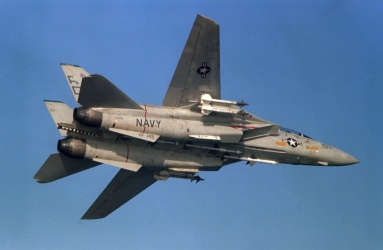
On 19 August 1981, two US Navy's F-14A Tomcats from VF-41 were engaged by two Libyan Su-22 in an event that would be known as the Gulf of Sidra incident.[7][8] As the Su-22s closed in, the lead plane fired a AA-2 "Atoll missile at the F-14s, but missed.[9] After evading the missile, the F-14s manoeuvred behind the Su-22s and, equipped with AIM-9L Sidewinders, each destroyed a Su-22 with the Sidewinders. The combat was concluded within 45 seconds.[8]
In 1982, the British would extensively use AIM-9L during the Falkland War on Sea Harriers. Procuring and using the AIM-9L were difficult as when the British carrier task force set sail to the Falklands in 05 April 1982, only 19 AIM-9L were in inventory. Moreover, the new canards on the AIM-9L did not fit the Sea Harrier's launch rails below the wings, though this was solved by filing down the launch rails for the AIM-9L to fit.[10] Sea Harriers equipped with AIM-9L fought in engagements against Argentine A-4 Skyhawks, Super Etendards, and Mirage IIIs.[11] By the end of the conflict, a total of 27 AIM-9Ls were launched which scored 24 hits on Argentine aircraft, which translates to an 88% success rate for the AIM-9L missile.[12]
Another conflict in 1982 that saw AIM-9Ls being used was the Israeli-Lebanon war. The Israelis launched Operation Mole Cricket 19 on 09 June 1982 to eliminate a Syrian air defense network set up in Lebanon's Bekaa Valley. The success of the Israeli operation forced the Syrians to commit their MiG-21s and MiG-23s to prevent the Israeli Air Force (IAF) from achieving aerial superiority. The IAF, consisting of F-15 and F-16 fighter jets, retained control of the sky as Airborne Warning And Control System (AWACS) aircraft informed Israeli pilots of the presence of Syrian jets, which were then intercepted and destroyed at visual range with AIM-9Ls, Shafrir, or Python missiles. The AIM-9L reportedly earned a kill rate of 85% during this conflict and contributed to the Israeli claim of destroying more than 80 Syrian aircraft, which only had K-13 missiles to fight back against the IAF aircraft.[11][12]
Future Sidewinder Variants
Though AIM-9L was a successful Sidewinder variant, there were still more features and improvements to be introduced into the model. Infrared Counter-Countermeasure (IRCCM) capability, a smaller smoke signature from the motor, and an improved WGU-4/B guidance system were implemented into the AIM-9L PIP that became the AIM-9M, which saw use during the Gulf War.[4]
The AIM-9L and future variants introduced many radical features that the United States deemed too sensitive for all allies, and export variants were produced that lacked some of the newer features. These export variants were labeled as AIM-9N, AIM-9P, and AIM-9S.[4]
Media
- Videos
See also
- Related development
External links
References
- Citations
- Bibliography
- Goebel, Greg. 2021. "The Falcon & Sidewinder Air-To-Air Missiles." Air Vectors. Last modified July 01, 2021. Website (Archive).
- Guardia, Mike. 2019. Tomcat Fury: A Combat History of the F-14. Maple Grove, MN: Magnum Books.
- Herbert, Adam J. 2007. "The Wars of Eighty-Two". Air Force Magazine. Last modified April 01, 2007. Website (Archive).
- Kopp, Carlo. 2014. "The Sidewinder Story: The Evolution of the AIM-9 Missile." Air Power Australia. Last modified January 27, 2014. Website (Archive)
- Parsch, Andreas. 2008. "AIM-9." Directory of U.S. Military Rockets and Missiles. Last modified July 09, 2008. Website (Archive)
- Westrum, Ron. 2013. Sidewinder; Creative Missile Development at China Lake. Annapolis, MD: Naval Institute Press.
- White, Roland. 2020. "Her Majesty's Death Ray: How The AIM-9L Sidewinder Vanquished The Argentine Air Force." The Drive. Last modified October 07, 2020. Website. (Archive)
- Young, James. 2021. "Freedom's "Flying Snake": The AIM-9 Sidewinder in the Cold War". Marine Corps University. Accessed January 07, 2022. Website (Archive).


